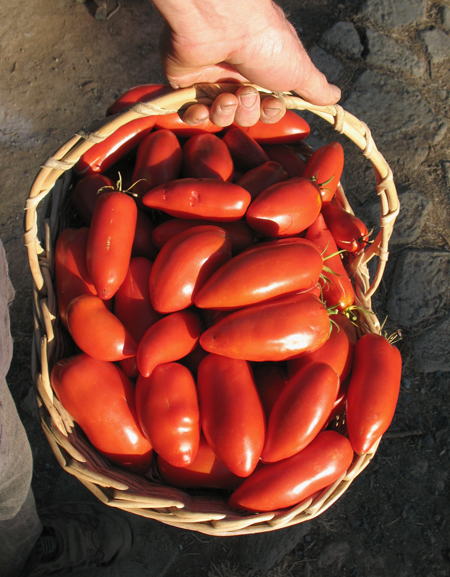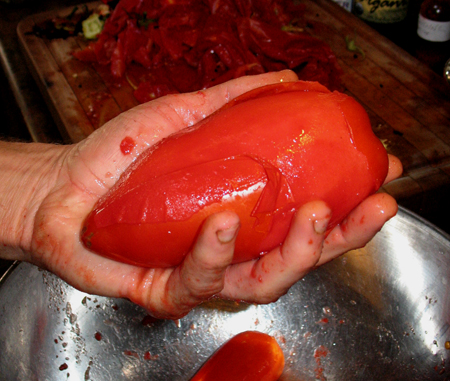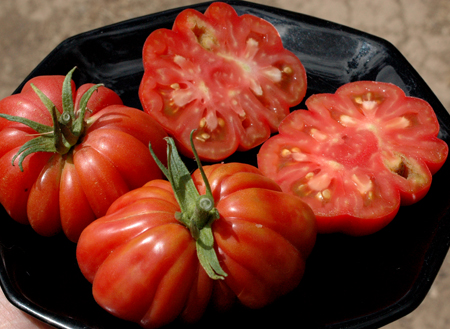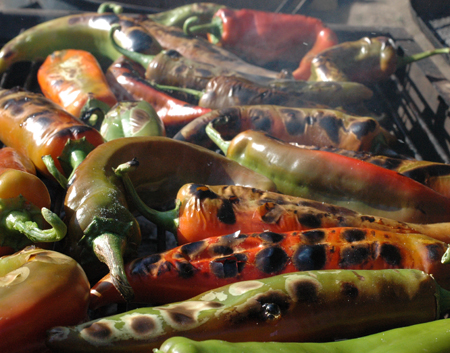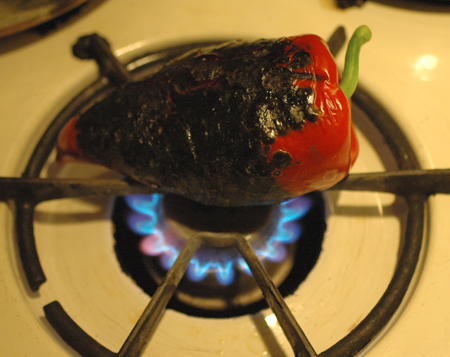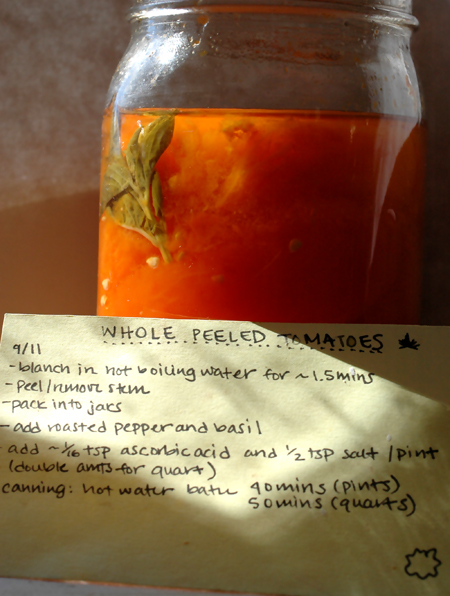 Tomato season is finally on here at 1800 feet in coastal Northern California. Having just mentioned canning tomatoes in the Mega Canner post, as well as also having recently been enjoying my few remaining jars of them, it occurred to me that my method of canning tomatoes might be of some use to other people. Over the years, I gradually devolved toward a very simple tomato canning system that is not too much work and leaves me with a very versatile product.
Tomato season is finally on here at 1800 feet in coastal Northern California. Having just mentioned canning tomatoes in the Mega Canner post, as well as also having recently been enjoying my few remaining jars of them, it occurred to me that my method of canning tomatoes might be of some use to other people. Over the years, I gradually devolved toward a very simple tomato canning system that is not too much work and leaves me with a very versatile product.
My mom made tomato sauces and such, but what I really remember was the whole canned tomatoes. I would sometimes beg a jar of them, open it, and just eat them out of the jar with a fork. Yum, they were so good! Home canned tomatoes are so much better than store bought!!! I don’t care what brand you buy, there is just no comparison, because the commercial tomatoes are always bred for processing rather than flavor, and are harvested too early... just what we should expect from an industrial model. One day I was thinking about what I wanted to eat. I thought spaghetti sounded good. I got the pasta water going, got the pasta cooking, saute’ed some onions and ground meat, then rummaged in the cupboard. NOOOOO!!!! I was out of home canned tomatoes! I was already salivating and could taste those yummy sweet tomatoes as they oozed into the spaces between the noodles, topped with slowly melting shreds of Asiago cheese. But wait, there was a can of storebought tomatoes, that would have to do. Nope, they were soooooo lame! Total buzzkill :-/
Since horking down cans of my moms tomatoes at 12, I have sometimes made sauces and paste, but anymore I only can whole peeled tomatoes. Aside from fond memories, the main reason I do so is versatility. I don’t have to figure how many cans of sauce I’ll use, or what kind of sauce I want to make, or anything like that. My whole canned tomatoes can be reduced to small pieces in the jar with a butter knife in a matter of seconds, or tossed in the blender to make pizza sauce, dropped whole into a casserole, or dumped straight into a pot of minestrone. I can use them in Asian food, Mexican, Italian etc and so on. There are no skins to get in the way, and the extra juice in the jar tastes amazing with a splash of hot sauce, perfect to sip on as an appetite stimulant while cooking, or as a treat to share with someone.
I’m not against other forms of canned tomatoes, but I’m an adventurous cook. I can’t put Italian spaghetti sauce in my chili, but I can make spaghetti sauce with my whole canned tomatoes when I need to. Using whole canned tomatoes is more like cooking with fresh ingredients. They are on the watery side, but I can put them in a pan on high heat and have them reduced to a sauce by the time the rest of the meal is cooked, if not before. Diced tomatoes, as a reader recently pointed out, are similarly versatile. I have made diced canned tomatoes, but it just seems like more work than is necessary since whole canned tomatoes are so easily reduced in the jar with a butter knife. And I do occasionally want the whole tomatoes, though admittedly not often. The basic method I use could be adapted to make diced canned tomatoes just as well if one wanted to.
There are times when a long cooked thicker sauce is where it’s at. Long cooking can develop deep rich flavors. But most of the time I’m after a less tortured, less concentrated flavor from my tomato dishes, and I can get that with whole canned tomatoes. I’ll admit that it’s less instant and convenient than sauce that is already cooked down and flavored and ready to go out of the jar, but I’ll also wager that sauce made with the same ingredients, cooked down with fresh herbs just before dinner from whole canned tomatoes, will be a cut above a precooked and pre-flavored canned sauce.
So here’s how I do it. Maybe you can put up a couple of jars this season and see how you like them.
What tomatoes to use: First, USE RIPE TOMATOES! Ripeness makes all the difference, and is your main weapon in superiority over commercially canned tomatoes. I prefer to use canning tomatoes, but will can any excess slicing types too. My favorite is probably Orange Banana (available from Fedco), a small yellow canning tomato with a very sweet fruity flavor. It is not suited to every dish because it has less of a classic tomato flavor, so I grow reds as well. I haven’t really settled on a red canning tomato yet, but there are lots to choose from out there. I think Blue Beech is in the lead for flavor so far (also available from Fedco... I'm a big Fedco fan if you can't tell). It is a large tomato, few seeds, dense, tasty and reasonably productive. Polish Linguisa produced like mad giving over 50 pounds off one plant in one picking, but the flavor lagged behind blue beech and others. I’m planning to can some Zapotec this year. It is a deeply pleated tomato with amazing flavor and seems fairly dense, though it’s a great slicing tomato. One red canning tomato that is popular is San Marzano. San Marzano gets a lot of press, but the year I grew it, this popular tomato seemed like a just above average commercial processing type, bred for holding in the field and to withstand lots of handling. My guess is that it is basically a gourmet industrial processing tomato, but that’s kind of like saying "gourmet non-dairy whipped topping". I also did not like Speckled Roman as it has too much stringy fibrous stuff in it. Early Girl makes a pretty decent canned tomato, though it is more watery and less dense than some canning types. Basically, I’ll can whatever I’ve got at the time, but it’s really worth it to grow one each of a bunch of different processing types and then taste test them after canning. Large tomatoes process much faster. Processing 20 pounds of small orange bananas is a lot of work (though it’s worth it!). (Edit: I forgot to mention that some tomatoes, notably canning/processing types, have a small stem end so they don't require coring out of the tops like most slicing tomatoes and heirlooms do. It really is a lot less work to prepare canning tomatoes which peel easily and have those small ends. Heirlooms, especially the big slicers, often have folds and pleats, cracks and scabby areas that have to be dealt with. Early Girl has a pretty small stem end, much like a processing type tomato.)
I add two other ingredients to almost all of my canned tomatoes- ripe roasted peppers and basil. It might seem like basil is limiting in that it is not suited to all cuisines, but I have not found that to be the case. I use only a small amount of fresh leaves stuffed in the top of the jar, and it seems to go fine with everything. Since I use a small amount, I don’t even really miss it when it’s not there and it should definitely be considered totally optional. I don’t even have a single basil plant this year, so I won’t be using any.
The pepper is roasted over an open flame, or better yet over hot coals, until blistered and a little charred. Drop the blistered hot peppers into a paper bag, or wrap them in a towel for a few minutes to sweat and loosen the skins. Slice them open, de-seed, scrape off most of the skin (a few remnants won’t hurt anyone) and cut into pieces. I probably put the equivalent of a roughly 2x2 inch square in each jar.
To prep the tomatoes, bring water to a boil and blanch them for just a minute or two. All you want to do is loosen the skin. If over cooked, some of the tomato will come off with the skin, and if under cooked, they will not peel easily. Ease of peeling varies from variety to variety. At their best, the tomatoes will just about slip right out of the skin. I use a large stock pot with a colander insert. When they are done, the colander is plunged into cold water briefly to halt cooking and cool the tomatoes off enough to peel easily. Bring the water to a boil between each scalding.
Throw the peeled tomatoes into a big bowl until you have a bunch of them. I like to line up a dozen or more jars at a time so I can add ingredients systematically without missing any. Clean your jars, or whatever you do. I just make sure they are washed clean. If they are clean off the shelf, I don’t even wash them. That’s what the sterilizing process is for. I use a lot of pints and some quarts, but it bears keeping in mind that quarts do save on buying lids, which are rather expensive when you add up the season's canning. Stuff the tomatoes into the jars leaving just a little space at the top since they will sink quite a bit in the canning water bath. Add the roasted pepper and basil, and for each pint use 1/2 tsp of salt and about 1/16 teaspoon of ascorbic acid.
About the ascorbic acid. I started using it because some sources claim that tomatoes are not always acidic enough to prevent the formation of botulinum toxins in the jars after canning. I actually don’t think that’s a problem, but my partner at the time always insisted on it and I didn’t think it hurt anything. Eventually I decided it tastes better though, and a taste test of commercially canned tomatoes done by COOKS Magazine came to the conclusion that those brands with added acidity (usually citric acid I think) were just better. It’s good stuff to have around anyway. You can add it to juice when your sick, and use a wash of ascorbic acid and water for rinsing fruit to keep it from oxidizing, useful for drying and canning.
After the jars are packed, wipe the rims clean and screw on the lids. I screw my lids on pretty firmly, but not super tight. Put into warm or cold water, just not so hot as to crack the jars. The jars should be resting on a grate to keep them off the bottom of the pan, and should be completely covered with water. Bring the pot to a boil with a lid on it. As soon as it begins boiling, you can set the timer. Boil hard for 40 minutes for pints and 50 minutes for quarts. I don’t remember where I got those numbers, but that’s how I do it. Allow the kettle to stop boiling and wait about a minute before removing the jars. If you remove them while too hot, they will boil over. You may or may not need to snug the lids down as soon as they come out, I usually do. Allow to air cool, check the seals, remove the rings, rinse the jars, label with the year, and with the variety for future taste testing if applicable, and stow away. If you have a ton of them to process, check out the Mega Canner post.
I’m not convinced that this is the very best way to do tomatoes, but I do know that it is a system that has served very well here with almost limitless versatility and I see little reason to tweak it in any way. These canned tomatoes have contributed to countless delicious meals here at Turkeysong. The rough number of canned tomatoes I try to shoot for in a year, assuming two people and occasional guests, is 100 pints. There are usually some jars left over when the canning season rolls around, but that is good since no one knows what the next year will bring. I am thinking of putting up some tomato juice this year if I have enough tomatoes because I like drinking the juice off the tomatoes so much. I can any left over juice that accumulates in the bowl of peeled tomatoes with a little salt and ascorbic acid added, but that only amounts to a quart or two a year. Probably the easiest way to preserve tomatoes is by freezing them whole. The skins slip off easily when the frozen tomatoes are run under the tap for a few seconds. But I usually prefer my canned tomatoes for most uses. Please tell us about how you preserve tomatoes, in the comments.


